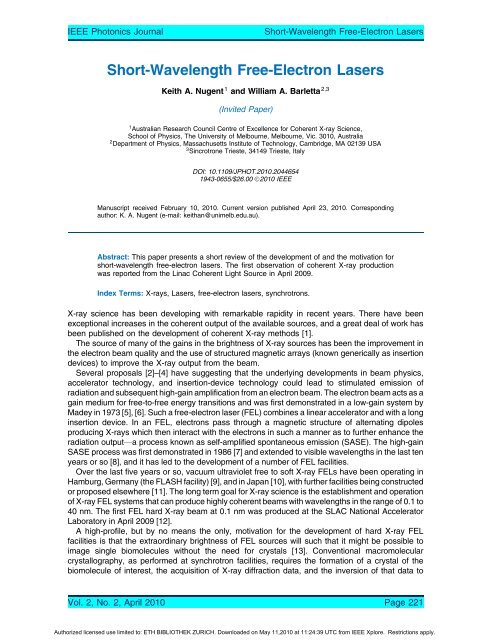Breakthroughs Breakthroughs - ETH - Ultrafast Laser Physics
Breakthroughs Breakthroughs - ETH - Ultrafast Laser Physics
Breakthroughs Breakthroughs - ETH - Ultrafast Laser Physics
You also want an ePaper? Increase the reach of your titles
YUMPU automatically turns print PDFs into web optimized ePapers that Google loves.
IEEE Photonics Journal Short-Wavelength Free-Electron <strong>Laser</strong>s<br />
Short-Wavelength Free-Electron <strong>Laser</strong>s<br />
Keith A. Nugent 1 and William A. Barletta 2;3<br />
(Invited Paper)<br />
1 Australian Research Council Centre of Excellence for Coherent X-ray Science,<br />
School of <strong>Physics</strong>, The University of Melbourne, Melbourne, Vic. 3010, Australia<br />
2 Department of <strong>Physics</strong>, Massachusetts Institute of Technology, Cambridge, MA 02139 USA<br />
3 Sincrotrone Trieste, 34149 Trieste, Italy<br />
DOI: 10.1109/JPHOT.2010.2044654<br />
1943-0655/$26.00 Ó2010 IEEE<br />
Manuscript received February 10, 2010. Current version published April 23, 2010. Corresponding<br />
author: K. A. Nugent (e-mail: keithan@unimelb.edu.au).<br />
Abstract: This paper presents a short review of the development of and the motivation for<br />
short-wavelength free-electron lasers. The first observation of coherent X-ray production<br />
was reported from the Linac Coherent Light Source in April 2009.<br />
Index Terms: X-rays, <strong>Laser</strong>s, free-electron lasers, synchrotrons.<br />
X-ray science has been developing with remarkable rapidity in recent years. There have been<br />
exceptional increases in the coherent output of the available sources, and a great deal of work has<br />
been published on the development of coherent X-ray methods [1].<br />
The source of many of the gains in the brightness of X-ray sources has been the improvement in<br />
the electron beam quality and the use of structured magnetic arrays (known generically as insertion<br />
devices) to improve the X-ray output from the beam.<br />
Several proposals [2]–[4] have suggesting that the underlying developments in beam physics,<br />
accelerator technology, and insertion-device technology could lead to stimulated emission of<br />
radiation and subsequent high-gain amplification from an electron beam. The electron beam acts as a<br />
gain medium for free-to-free energy transitions and was first demonstrated in a low-gain system by<br />
Madey in 1973 [5], [6]. Such a free-electron laser (FEL) combines a linear accelerator and with a long<br />
insertion device. In an FEL, electrons pass through a magnetic structure of alternating dipoles<br />
producing X-rays which then interact with the electrons in such a manner as to further enhance the<br />
radiation outputVa process known as self-amplified spontaneous emission (SASE). The high-gain<br />
SASE process was first demonstrated in 1986 [7] and extended to visible wavelengths in the last ten<br />
years or so [8], and it has led to the development of a number of FEL facilities.<br />
Over the last five years or so, vacuum ultraviolet free to soft X-ray FELs have been operating in<br />
Hamburg, Germany (the FLASH facility) [9], and in Japan [10], with further facilities being constructed<br />
or proposed elsewhere [11]. The long term goal for X-ray science is the establishment and operation<br />
of X-ray FEL systems that can produce highly coherent beams with wavelengths in the range of 0.1 to<br />
40 nm. The first FEL hard X-ray beam at 0.1 nm was produced at the SLAC National Accelerator<br />
Laboratory in April 2009 [12].<br />
A high-profile, but by no means the only, motivation for the development of hard X-ray FEL<br />
facilities is that the extraordinary brightness of FEL sources will such that it might be possible to<br />
image single biomolecules without the need for crystals [13]. Conventional macromolecular<br />
crystallography, as performed at synchrotron facilities, requires the formation of a crystal of the<br />
biomolecule of interest, the acquisition of X-ray diffraction data, and the inversion of that data to<br />
Vol. 2, No. 2, April 2010 Page 221<br />
Authorized licensed use limited to: <strong>ETH</strong> BIBLIOTHEK ZURICH. Downloaded on May 11,2010 at 11:24:39 UTC from IEEE Xplore. Restrictions apply.

















